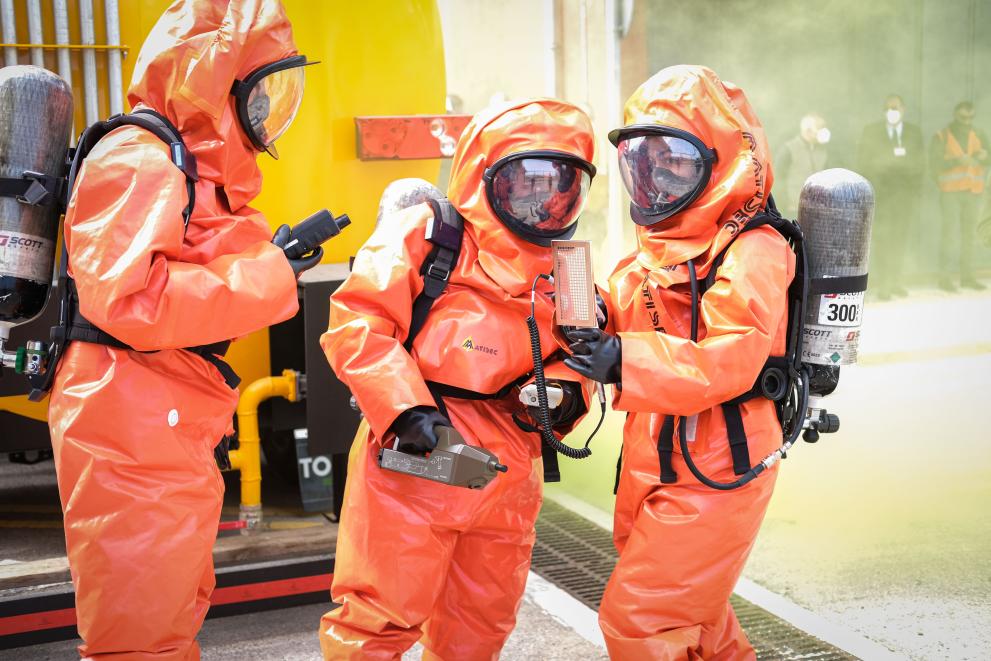
Chemical and biological agents have often been used deliberately to harm human beings and the surrounding environment. Gas mustard, nerve agent sarin, biological anthrax spores, or chemical weapons, are a few of the hazardous materials that have been intentionally released in the past to disrupt life. The high impact of any incident involving the use of such and similar agents testify to the relevance of increasing awareness and the skills needed to investigate and prosecute chemical and biological crimes.
The European Union has supported within the framework of the EU CBRN CoE the development and implementation of a series of capacity building and training packages that will strengthen the knowledge and skills needed to collect evidence and prosecute chemical and biological crimes. The learning package unrolled covers important aspects necessary to bring the case from the contaminated crime scene to be adjudicated in the courtroom, providing guidance to prosecutors, judicial and law enforcement authorities involved in the prosecution of such crimes.
The delivery of the capacity building and training package is an essential component of the recently published ‘Prosecutors Guide to Chemical and Biological Crimes’, with a view to operationalize and integrate the Guide as part of the professional duties of relevant authorities and ensure the sustainability of this global effort. Developed by UNICRI, in close cooperation with international organisations and stakeholders such as the OPCW and the International Association of Prosecutors (IAP), the Guide provides prosecutors, judges, law enforcement and relevant investigative agencies, with guidance to support the successful prosecution and adjudication of incidents involving the deliberate acquisition, stockpiling, production, transfer, or use/misuse of a chemical or biological agent.
Chemical Weapons Convention Review Conference
The ‘Prosecutors Guide to Chemical and Biological Crimes’ and its capacity building and training package were showcased on the occasion of 5th Review Conference of the Chemical Weapons Convention (CWC), on 17 May 2023 in The Hague, Netherlands. The event gathered several OPCW states parties and stakeholders around the table to discuss the relevance of this guidance, and the status of current and emerging challenges related to the prosecution and adjudication of such crimes.
The European Union, UNICRI and the International Association of Prosecutors informed about their coordinated efforts to advance the prosecution of chemical and biological crimes. The event highlighted the existing needs of prosecution authorities in terms of capacity building and training, and presented a series of capacity building and training activities conducted by the CoE network in different partner countries to strengthen the prosecution of these crimes. CBRN subject matter experts from the EU CoE on-site technical assistance and the Netherland Forensic Institute shared their experiences in the investigation and prosecution of CBRN crimes, with topics ranging from forensic investigation and scientific support for the prosecution of such crimes, to cooperation of military CBRN units with investigators and prosecutors, or the challenges of analysis and intermediate storage of toxic chemicals in a criminal case, among others.
A project rooted in the Centres of Excellence’s network
The ‘Prosecutors Guide to Chemical and Biological Crimes’ is an effort that came as a result of implementing two CoE projects in the South East and Eastern Europe region aimed to enhance the CBRN forensic capabilities across its countries. After completion of these in 2020, it was suggested to consider the possibility of developing internationally endorsed guidance to strengthen CBRN forensics capabilities to respond to, and cope with, related incidents.
The high-level document is the first in a series of CBRN forensics guidebooks aimed to advance guidance on policies, recommendations and best practices to enforce and build up forensics capabilities in the domain, where multi-agency coordination and cooperation is essential for the successful investigation and prosecution of criminal cases.
The second release in the series will be the ‘Prosecutor’s Guide to Radiological and Nuclear Crimes’, in collaboration with the International Atomic Energy Agency (IAEA), the United Nations Office on Drugs and Crime, IAP, and the Joint Research Centre, the European Commission’s science and knowledge service. The series will be completed with the ‘Chemical and Biological Crime Scene Management Guide’, with the support of the international partners.
The ‘Prosecutor's Guide to Chemical and Biological Crimes’ is fully available for free consultation on the link below.
Details
- Publication date
- 17 May 2023
- Authors
- Service for Foreign Policy Instruments | Joint Research Centre
- CBRN areas
- Bio-safety/bio-security
- Crisis management
- Denying support for misuse and terrorism
- First response
- Illicit trafficking
- Investigation and prosecution
- Protection of material/facilities
- Public and infrastructure protection
- Public health impact mitigation
- Safety and security
- CBRN categories
- Chemical
- Biological
- Radiological
- Nuclear
